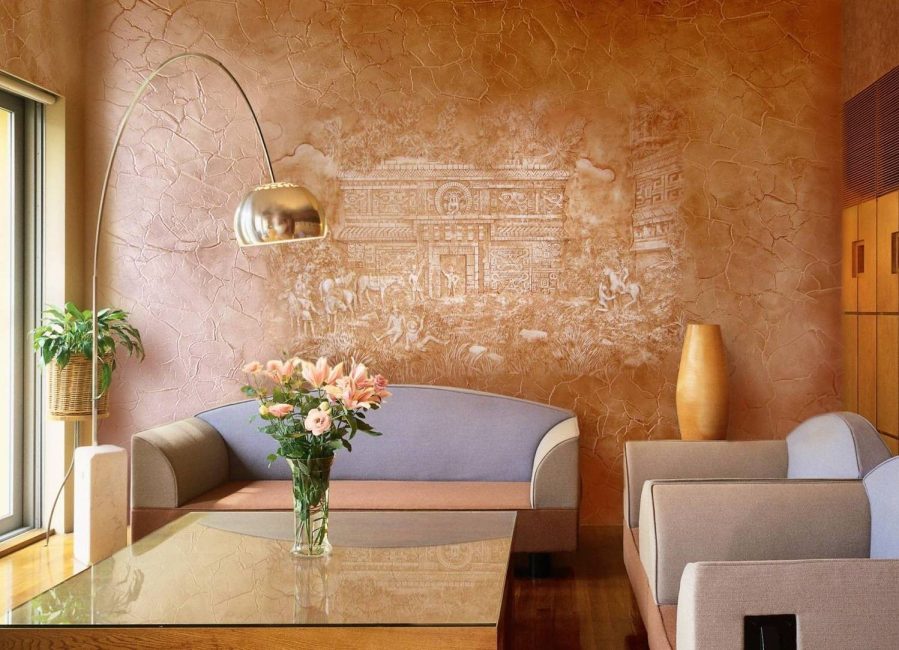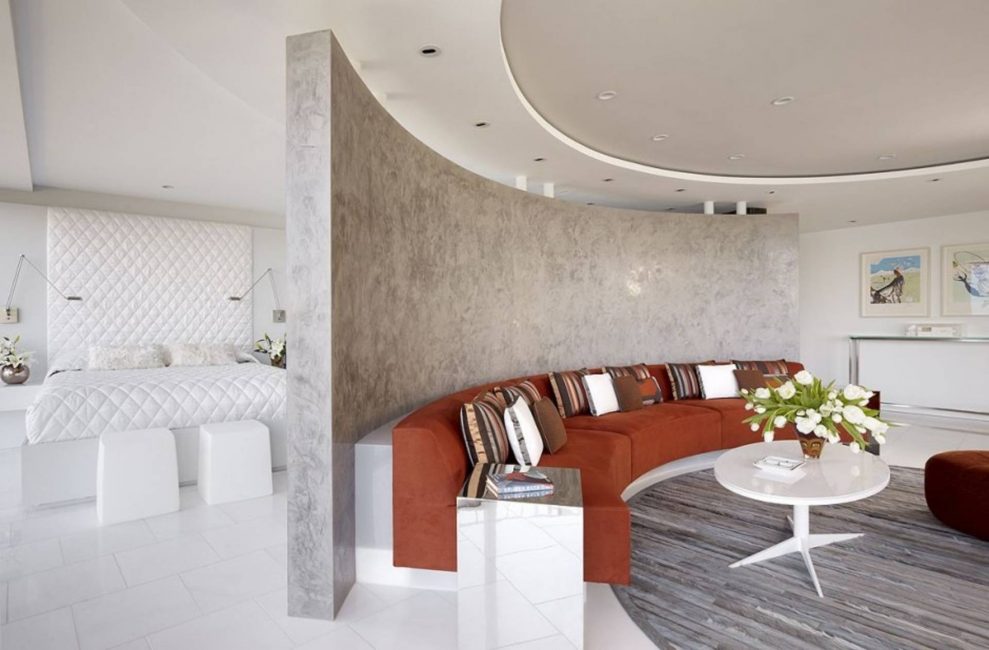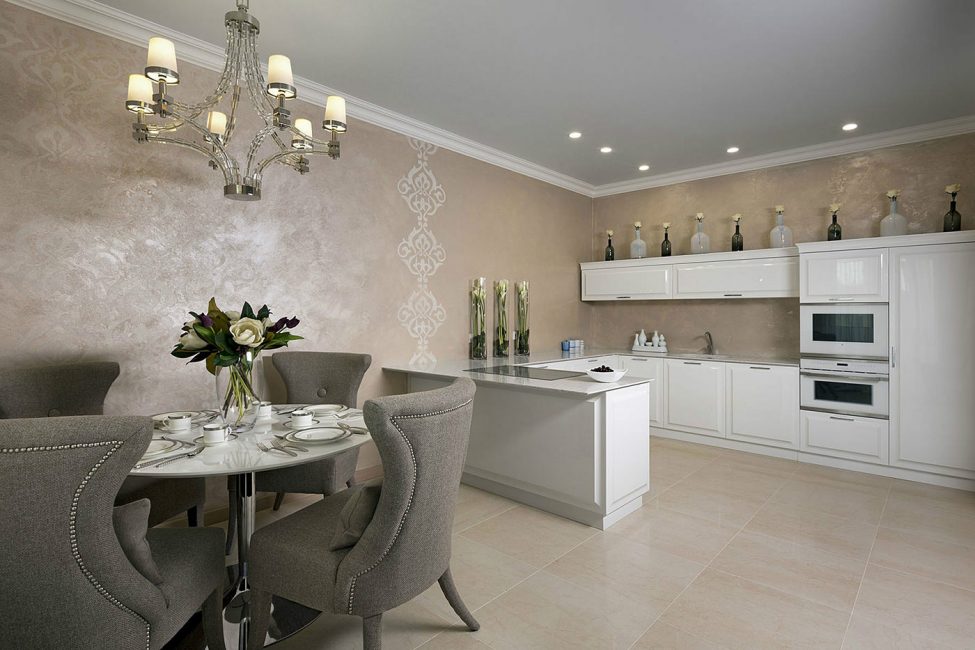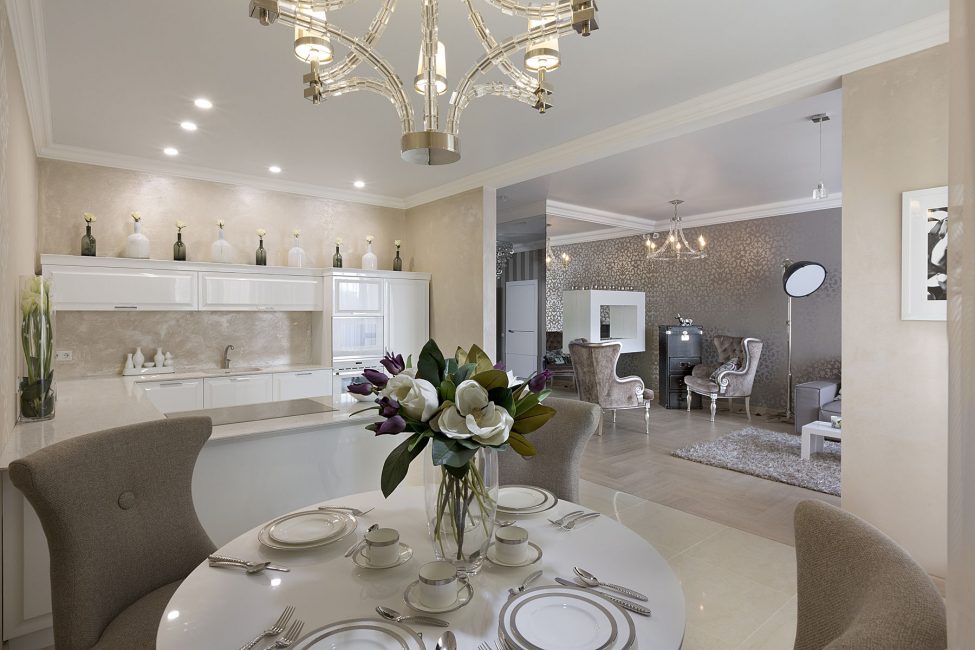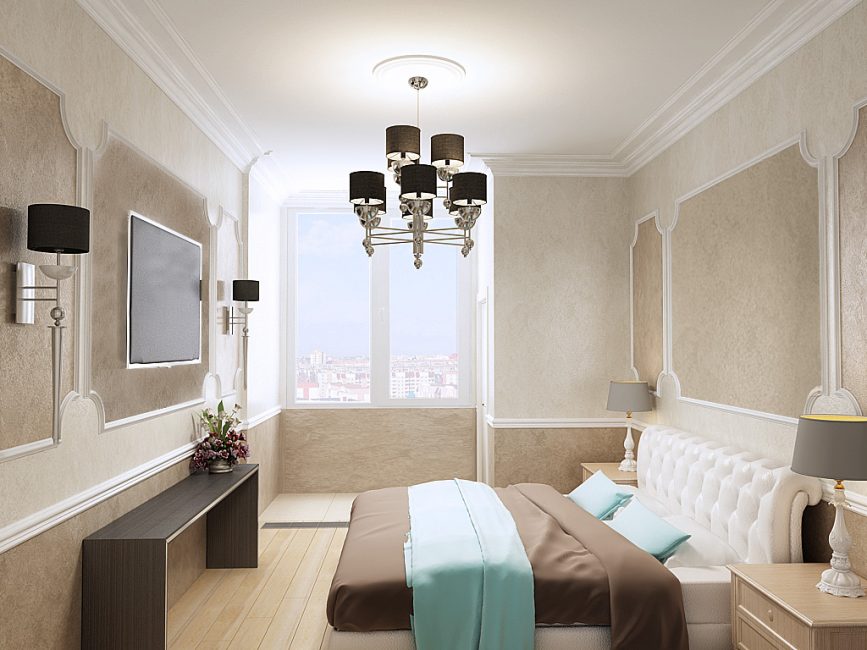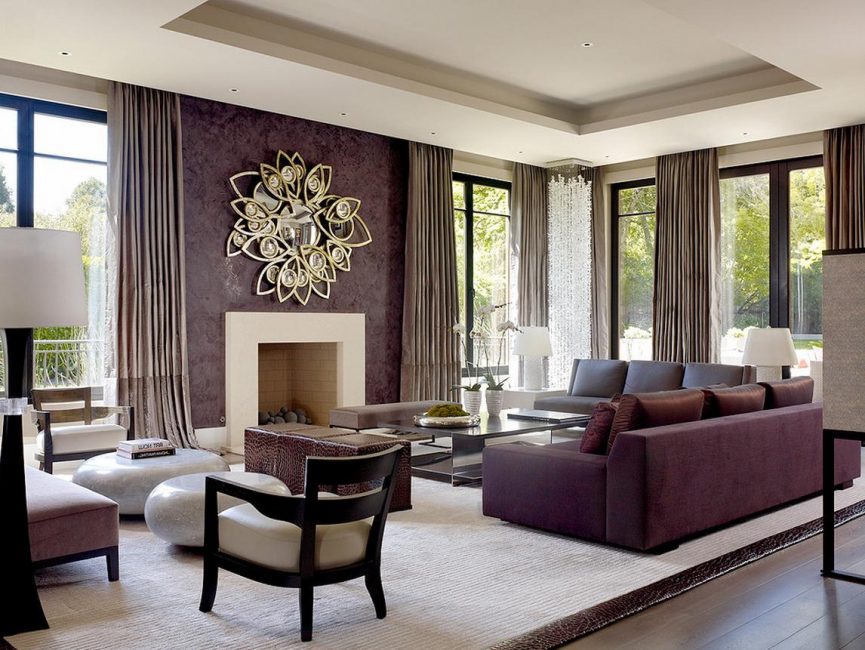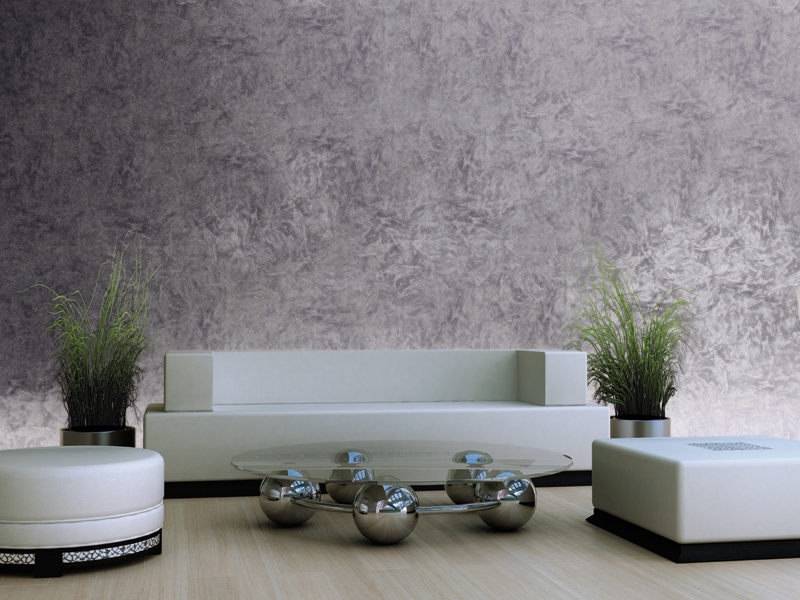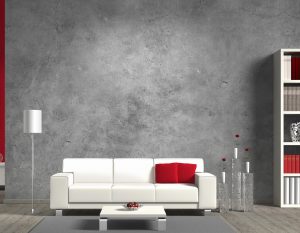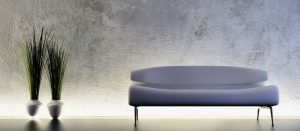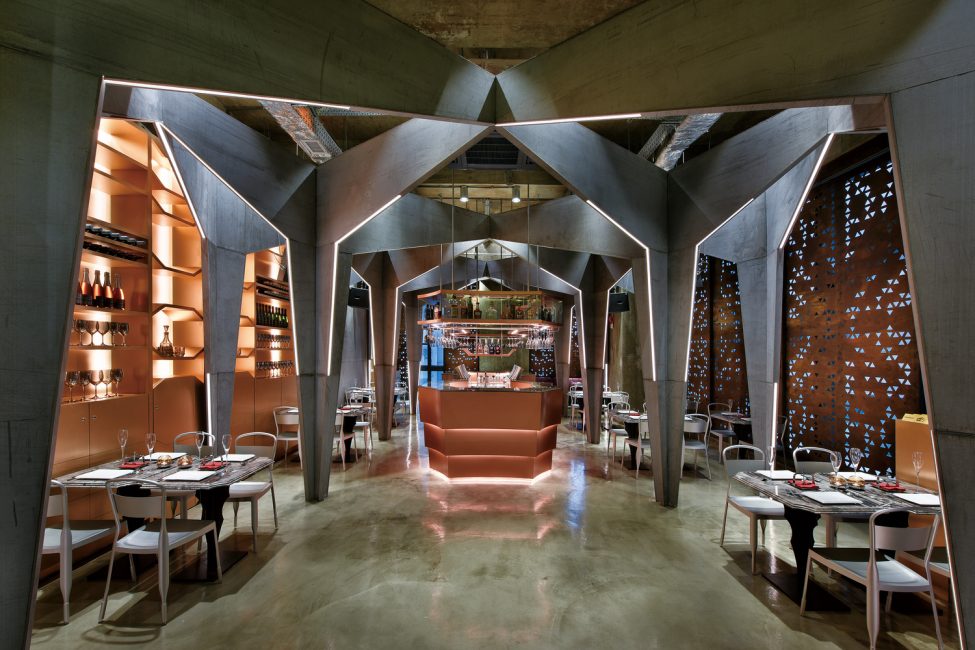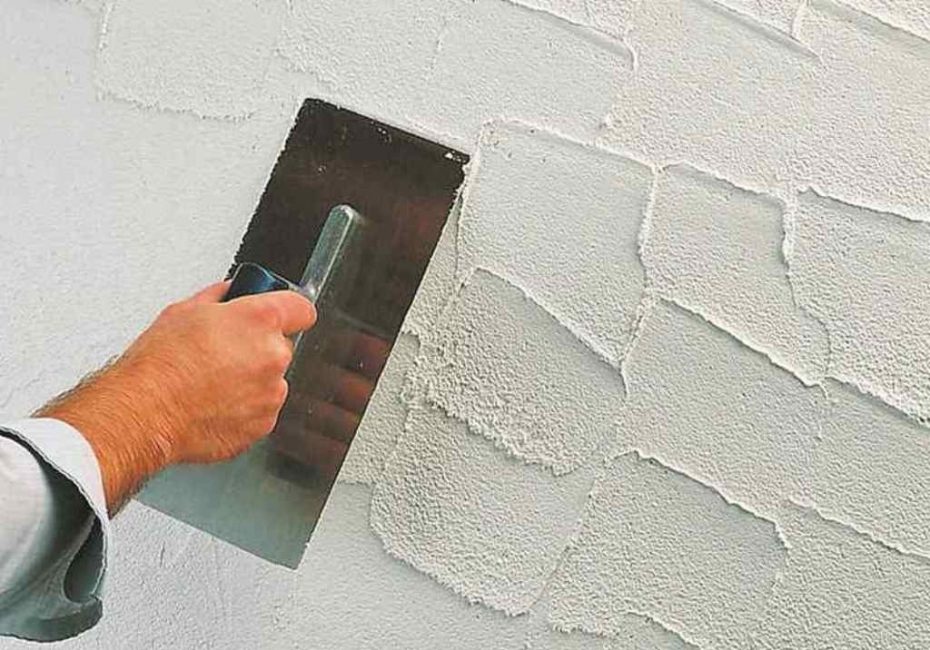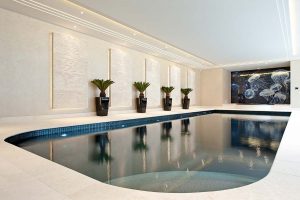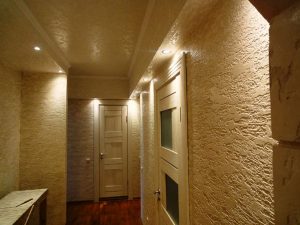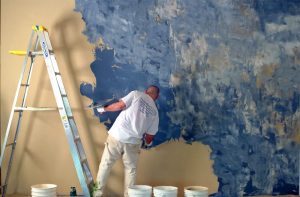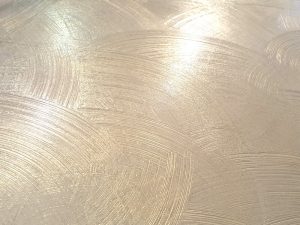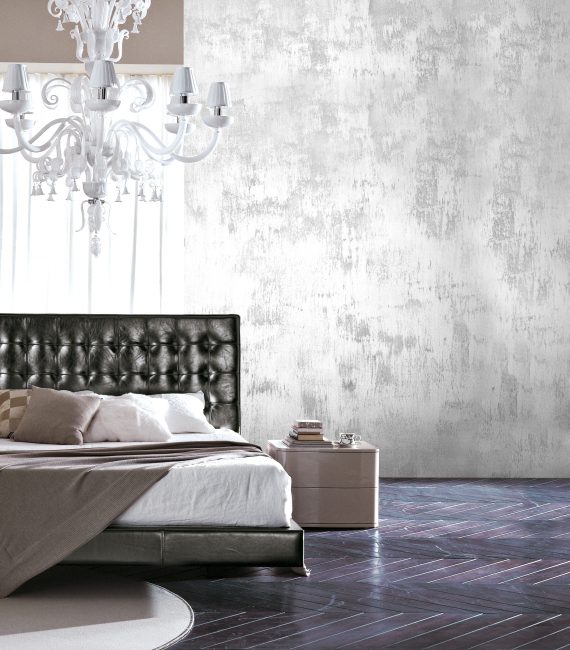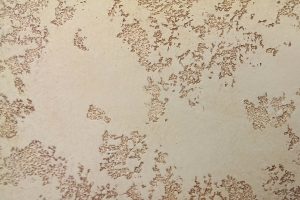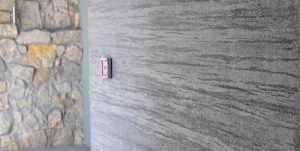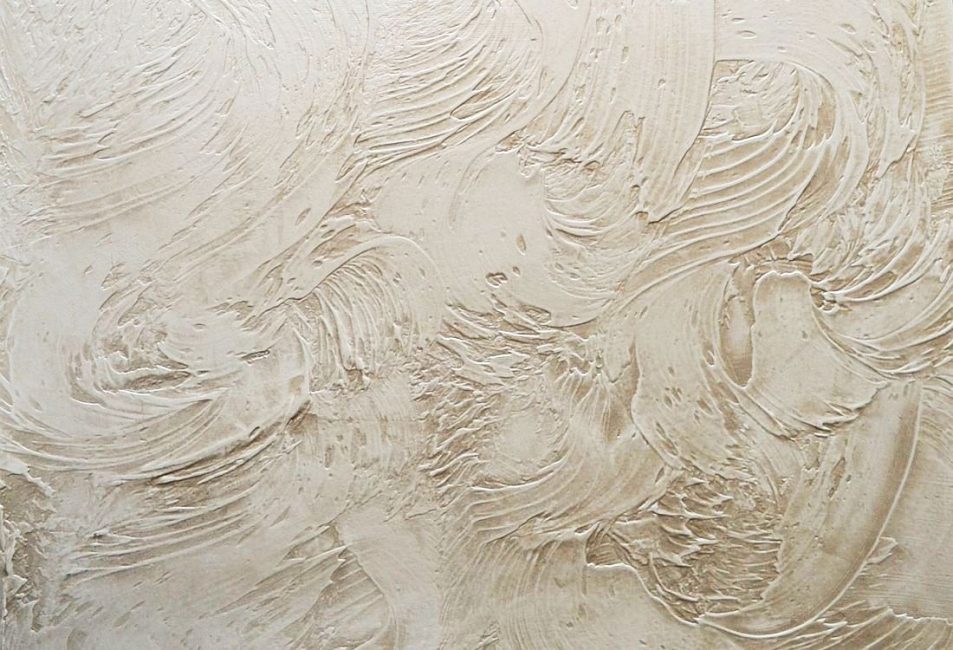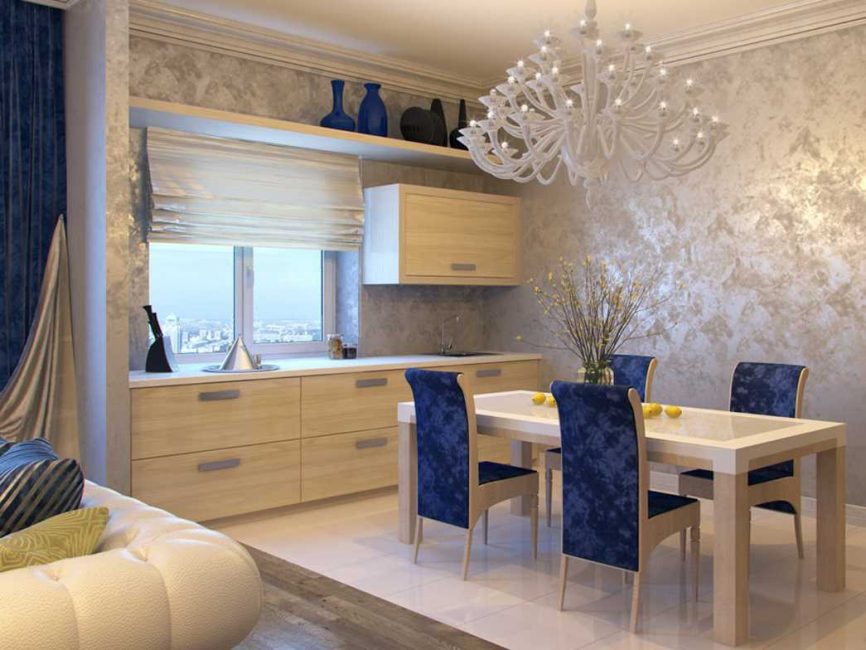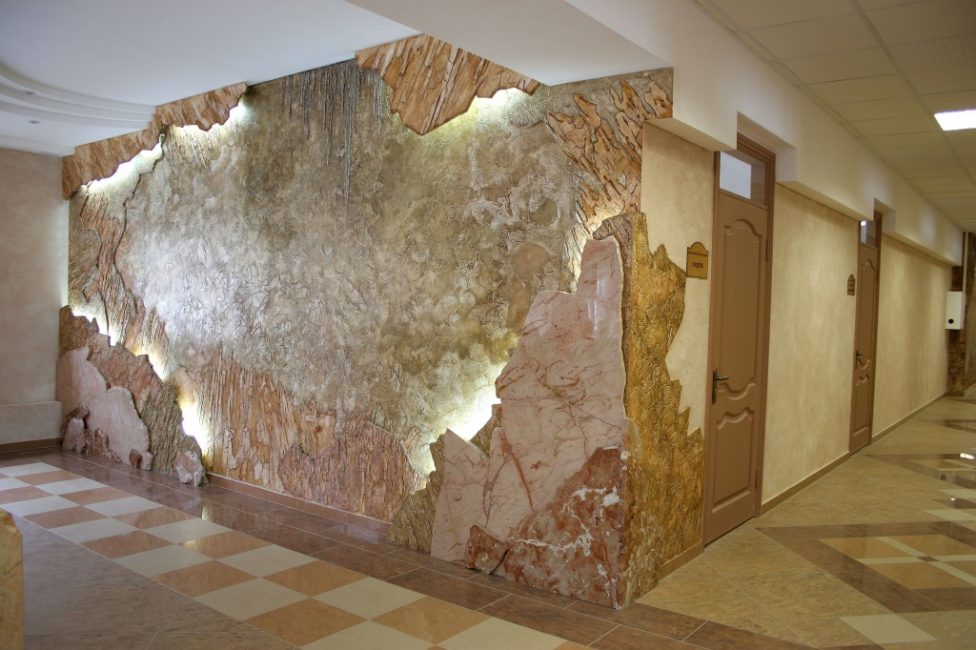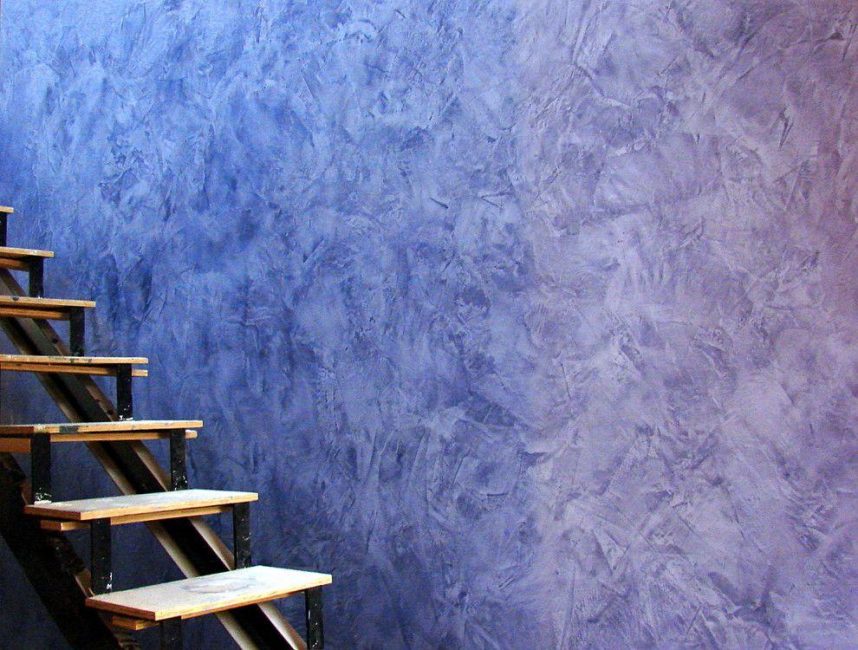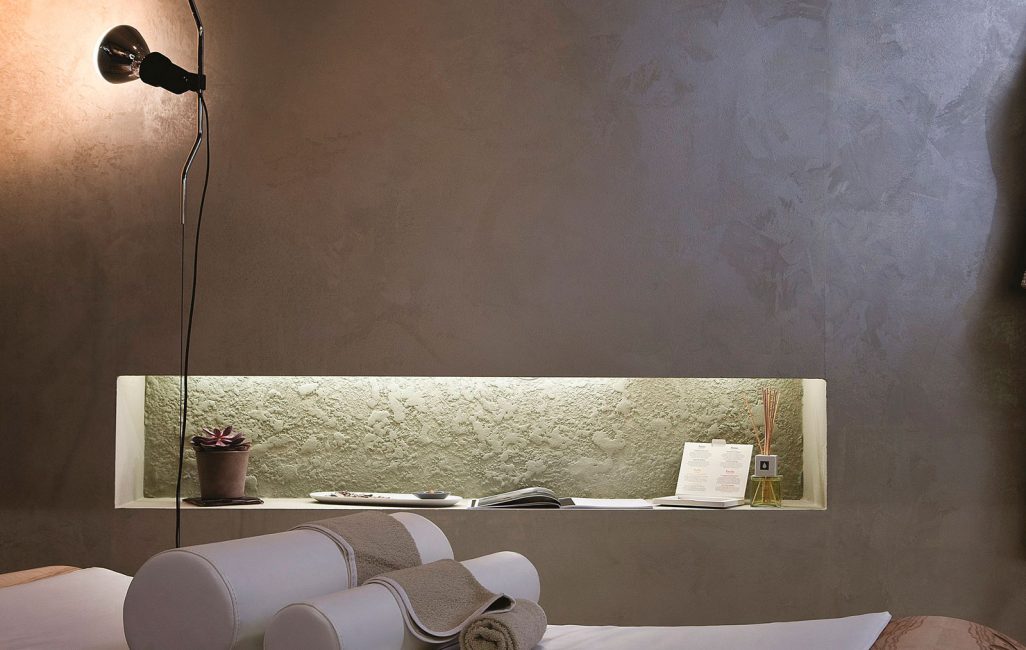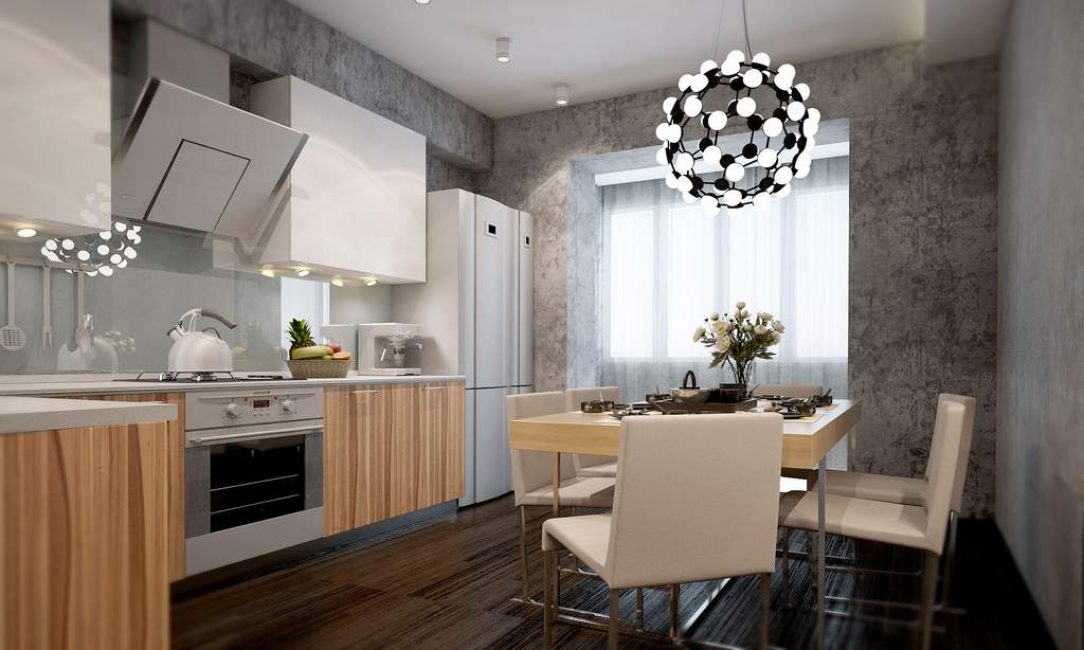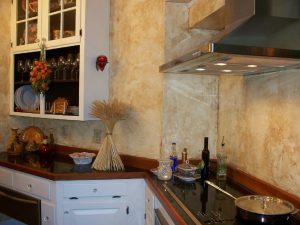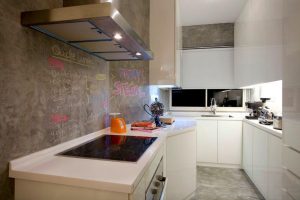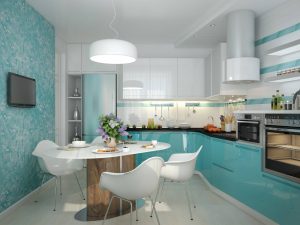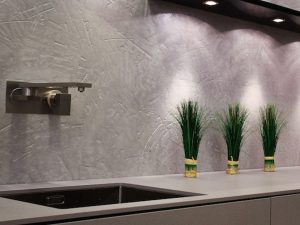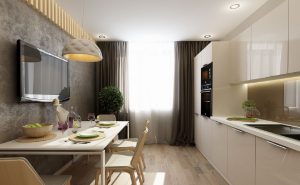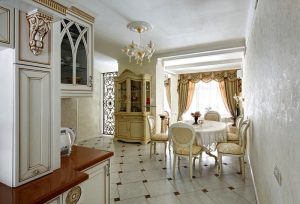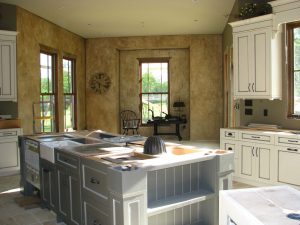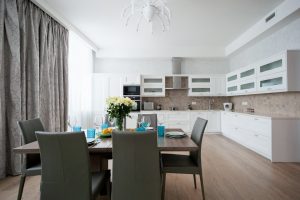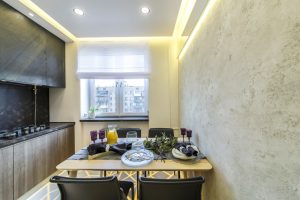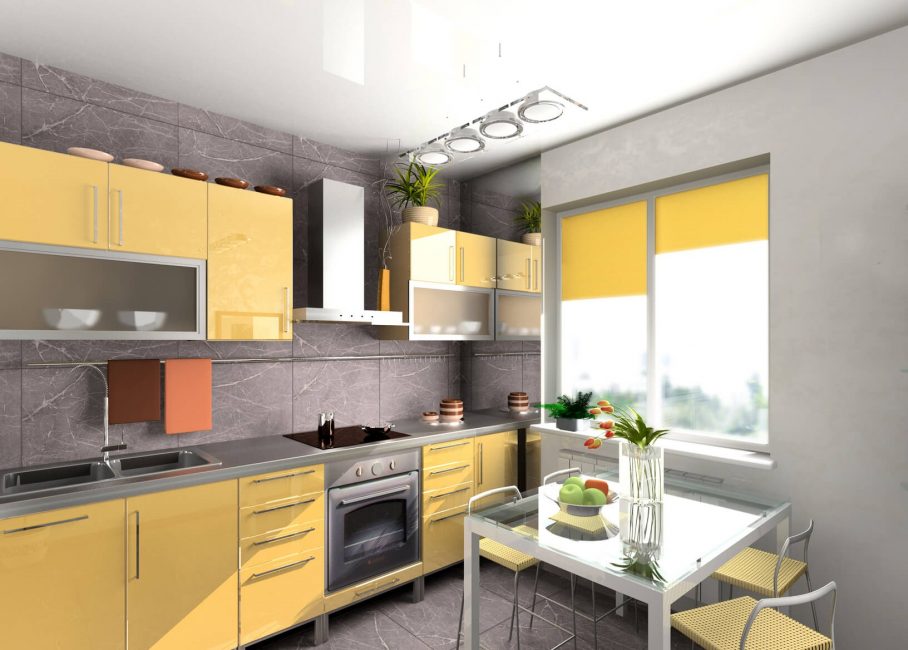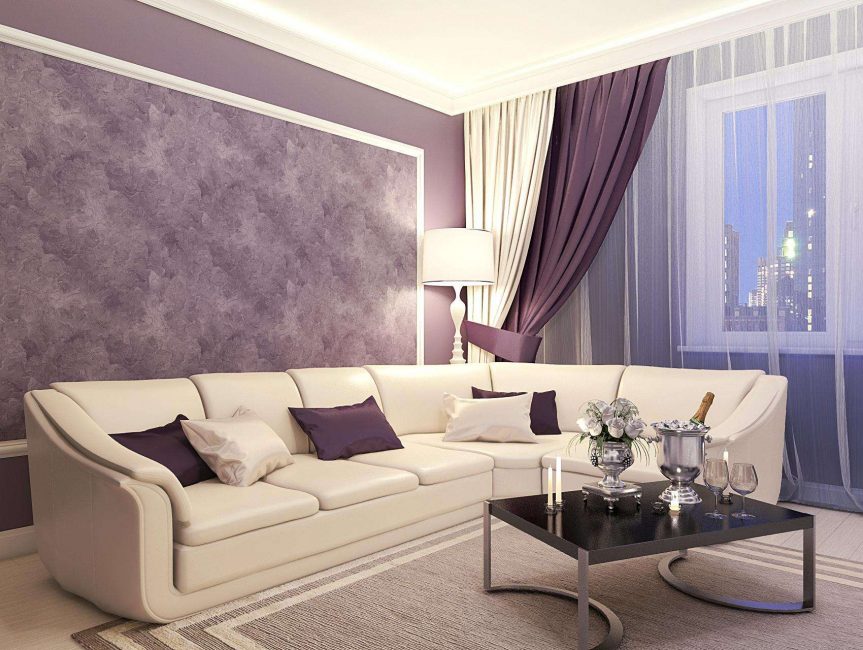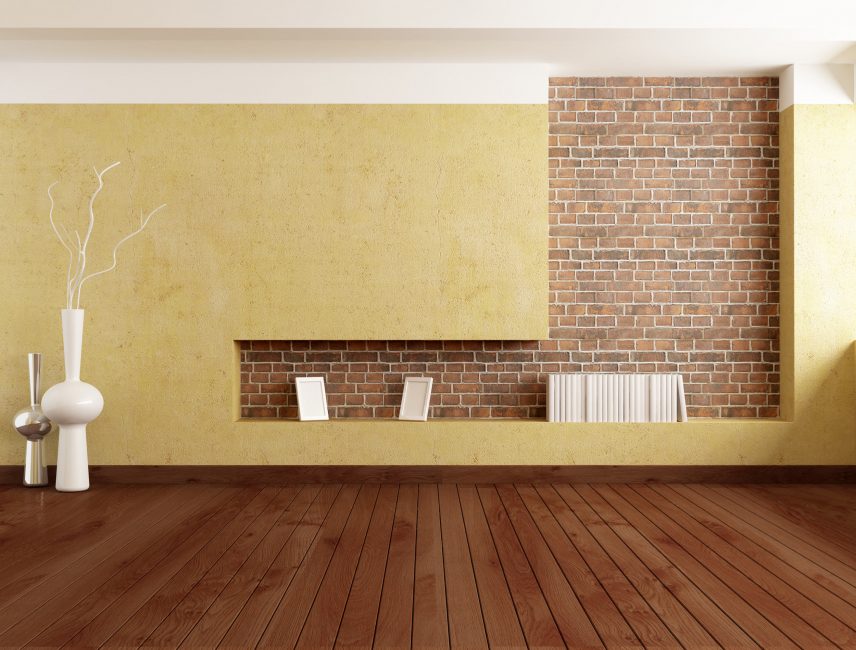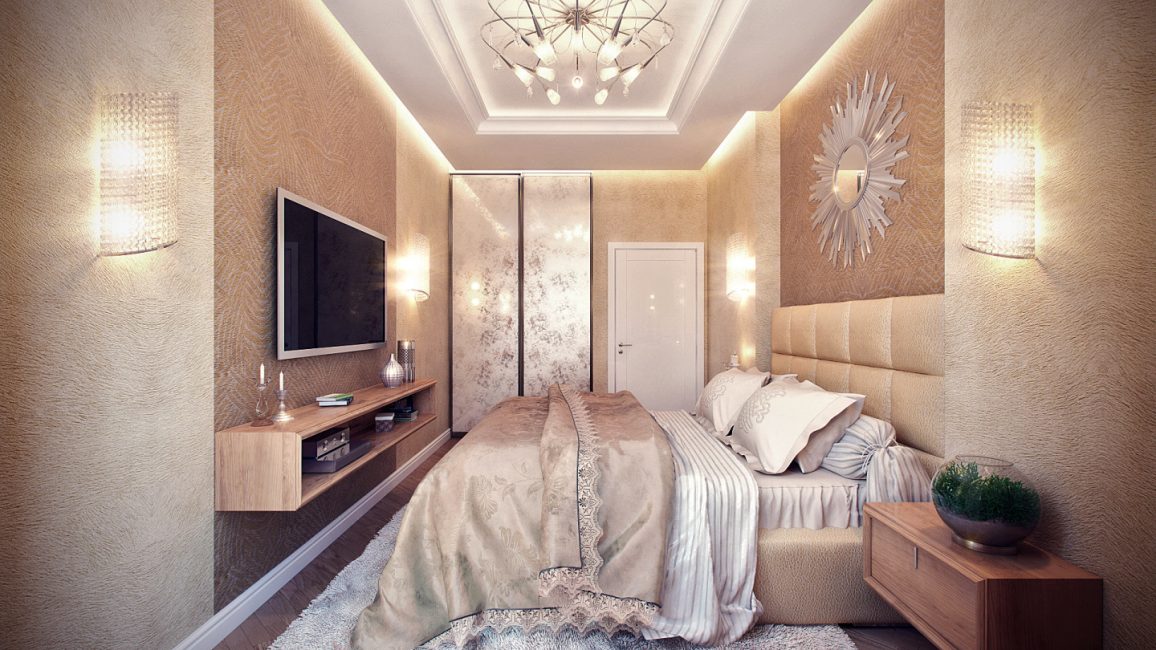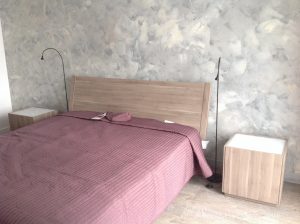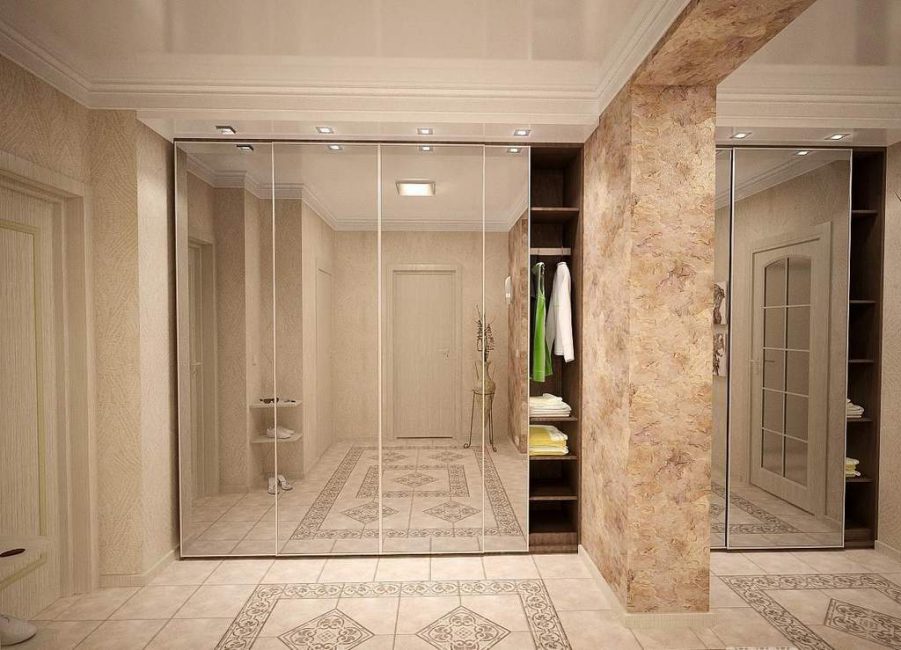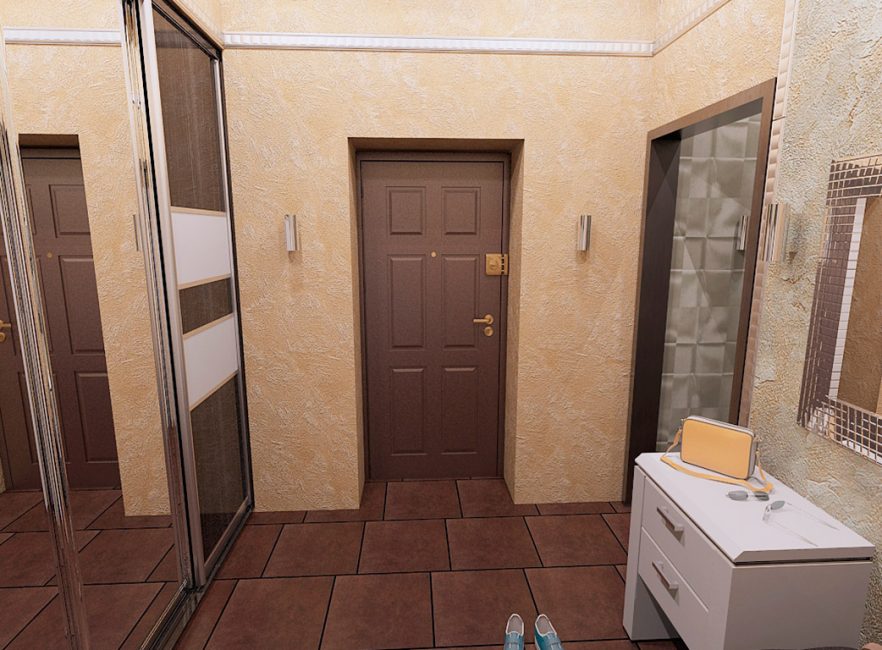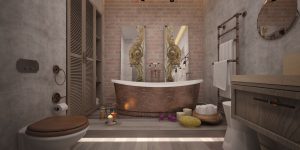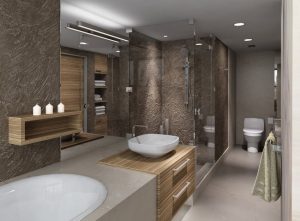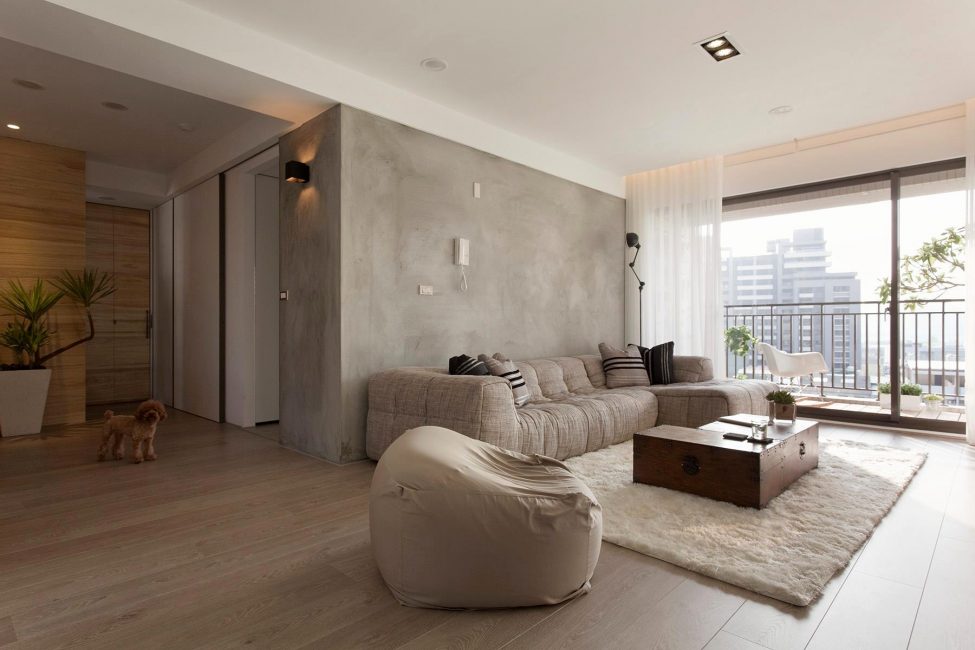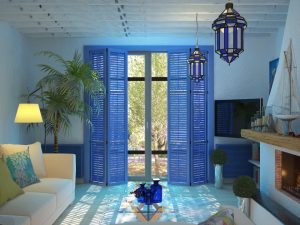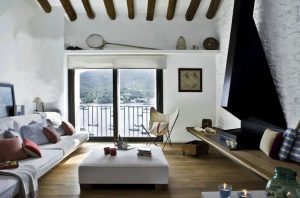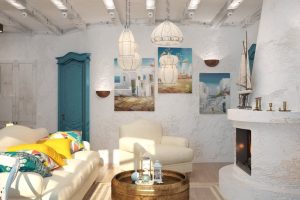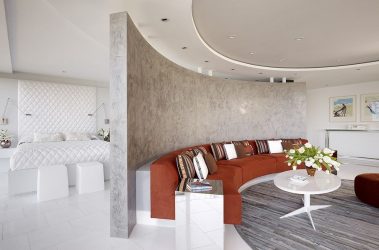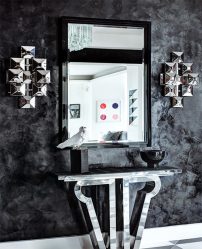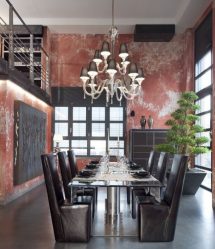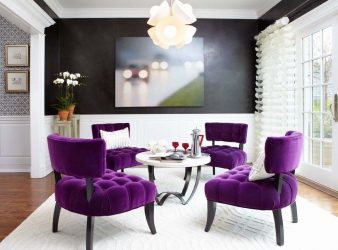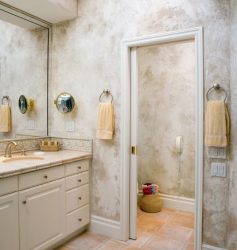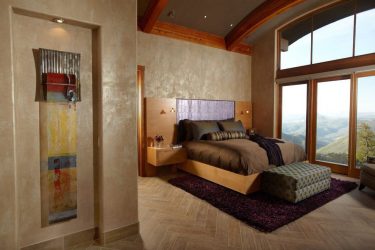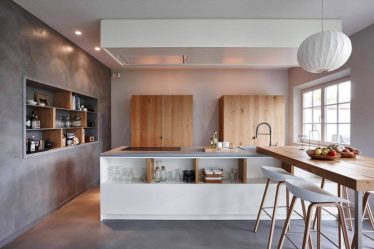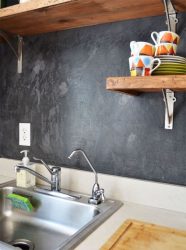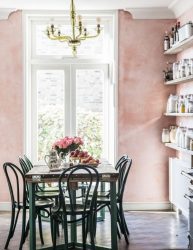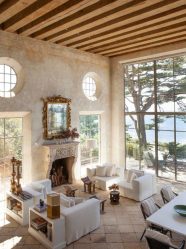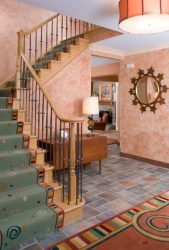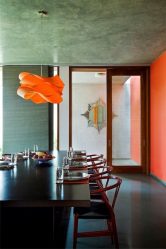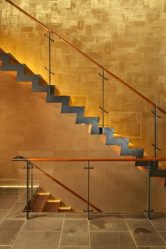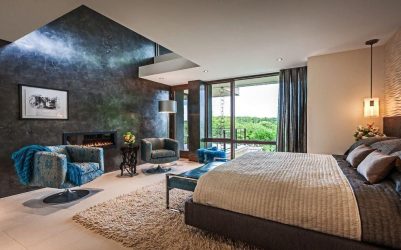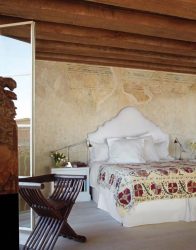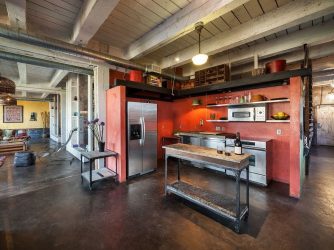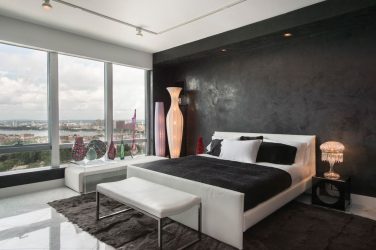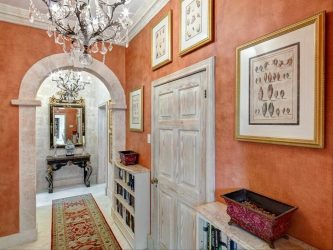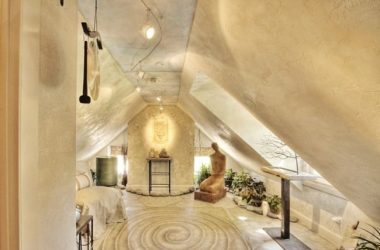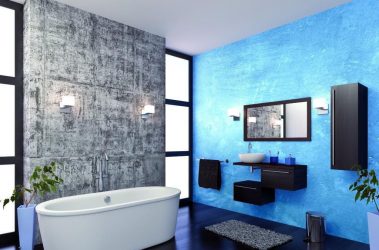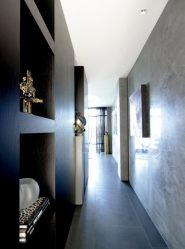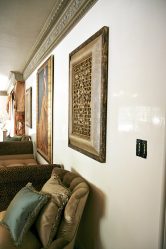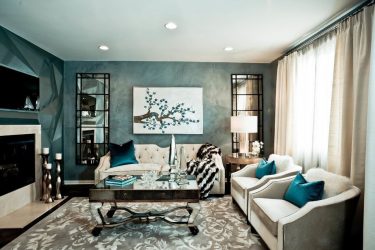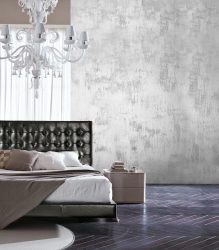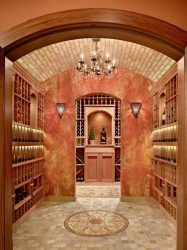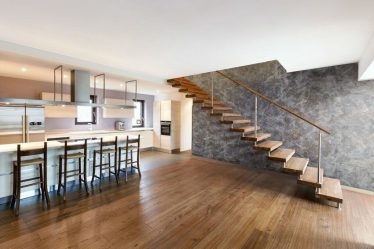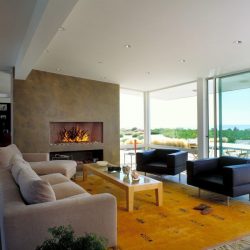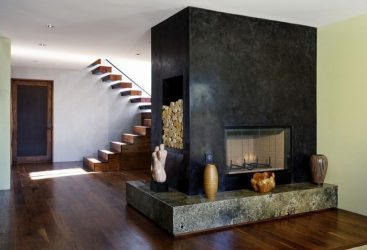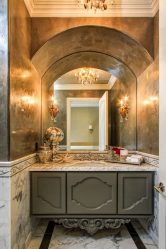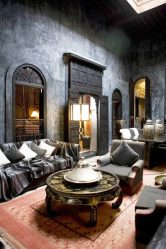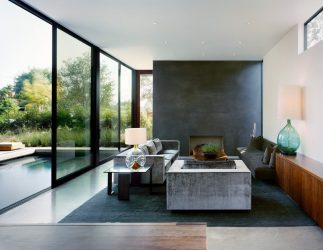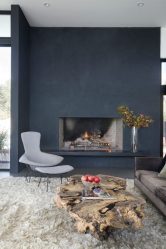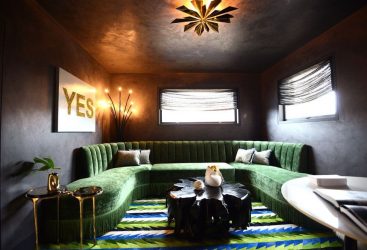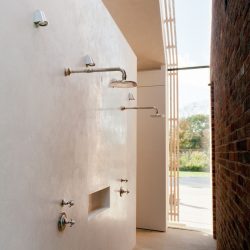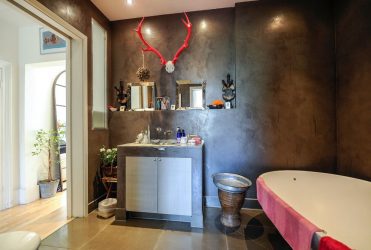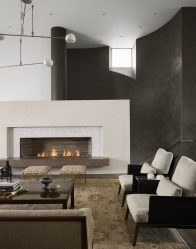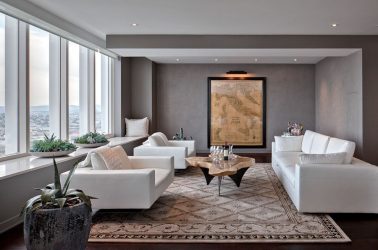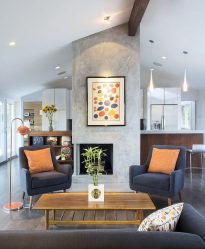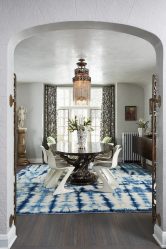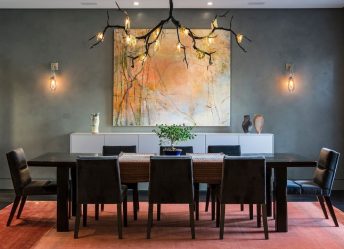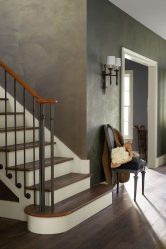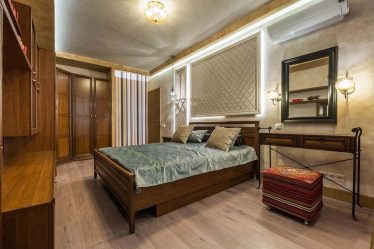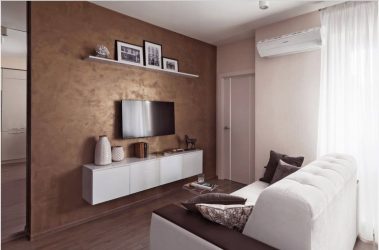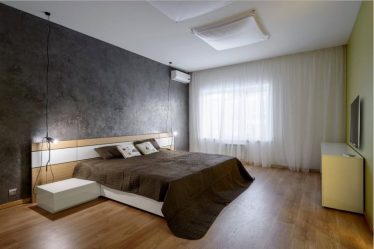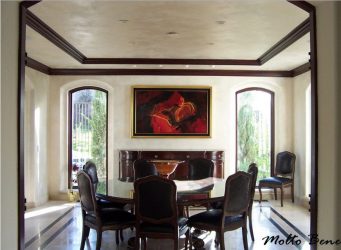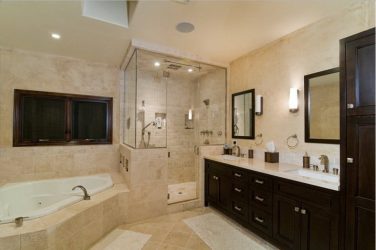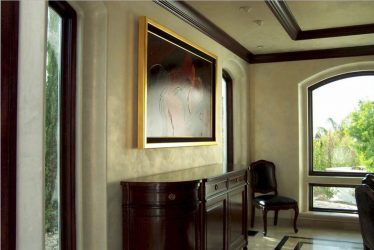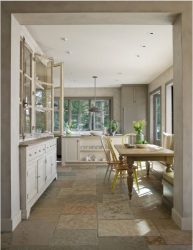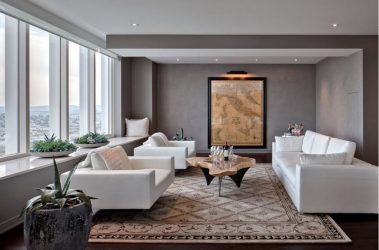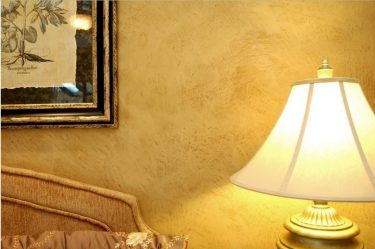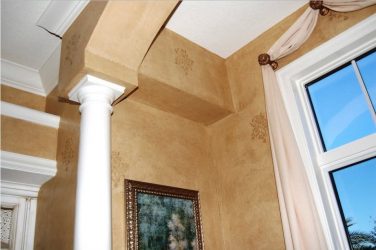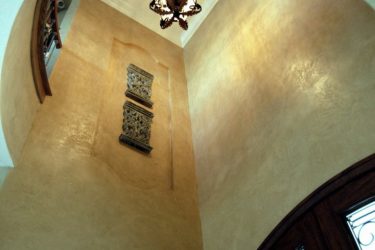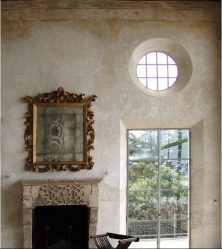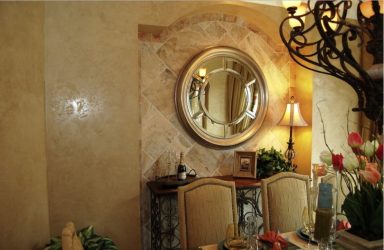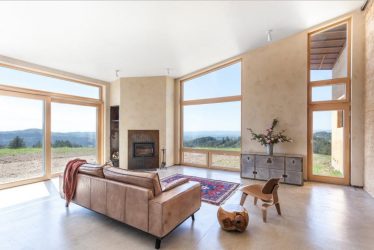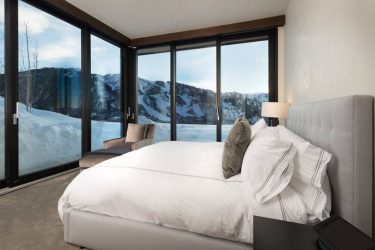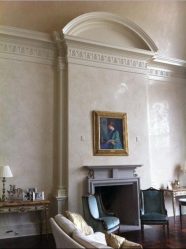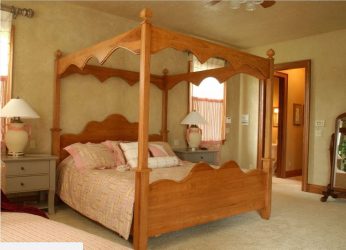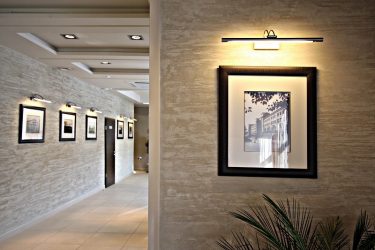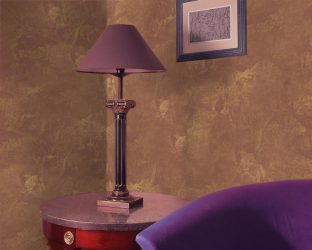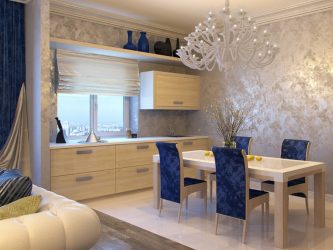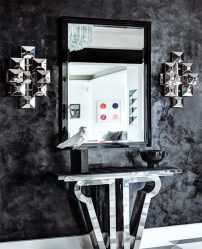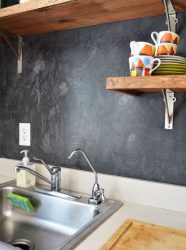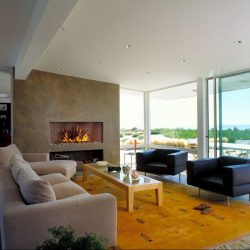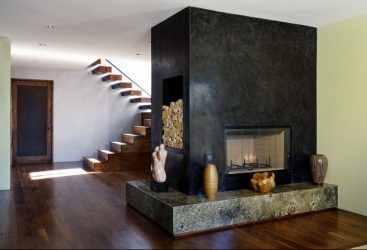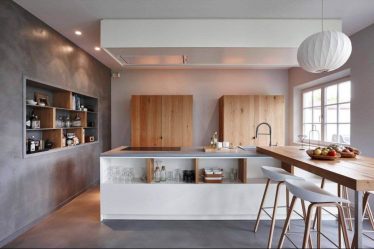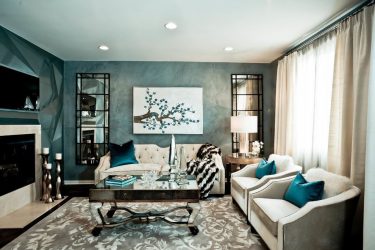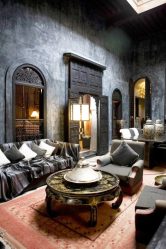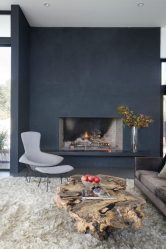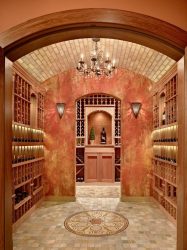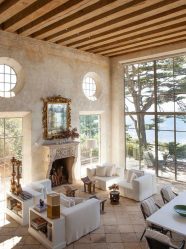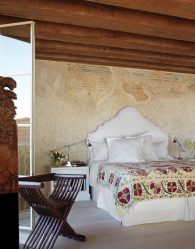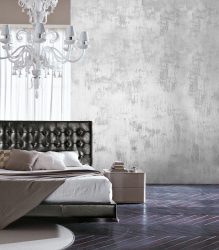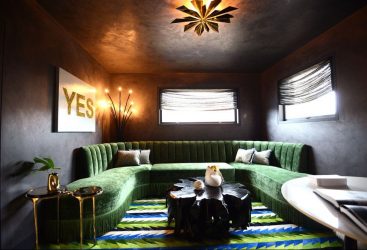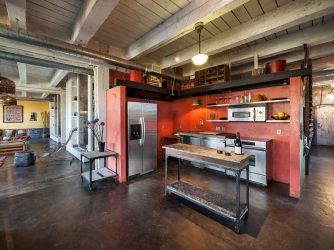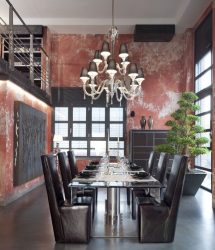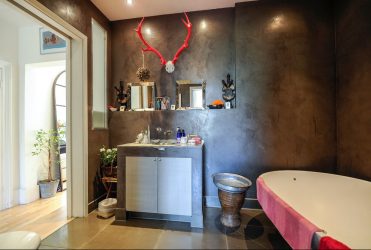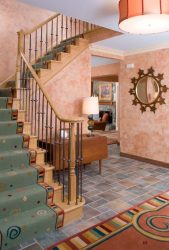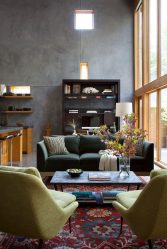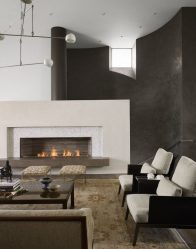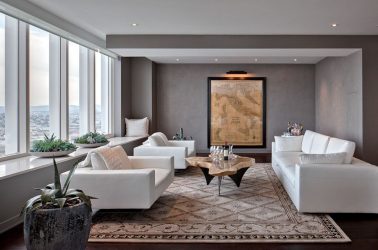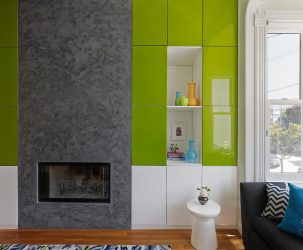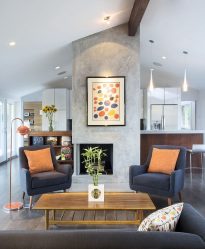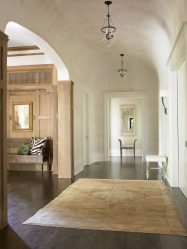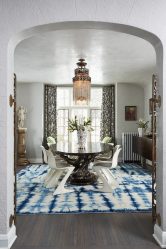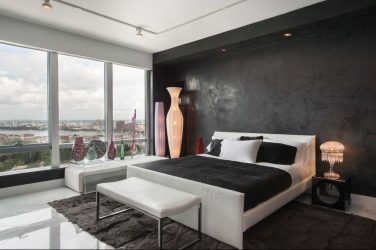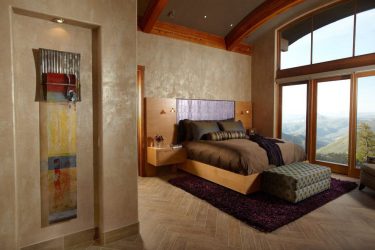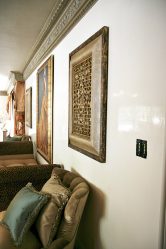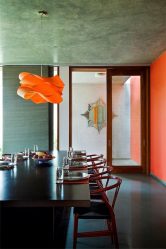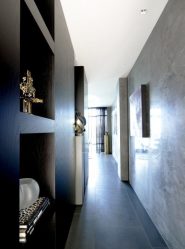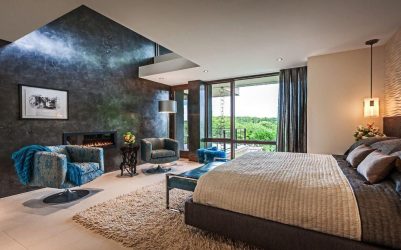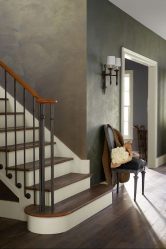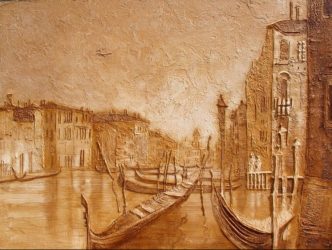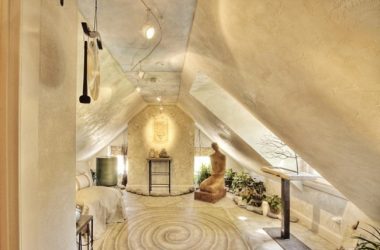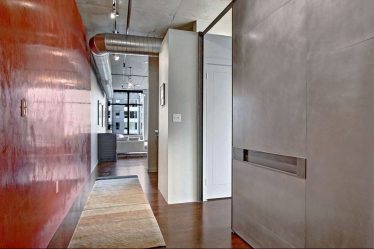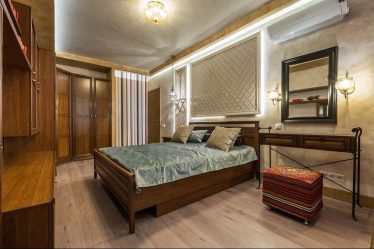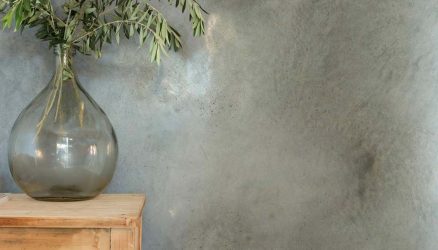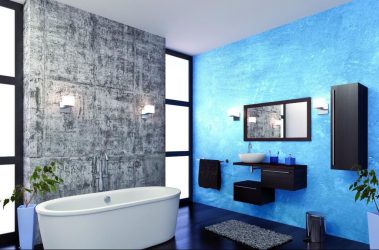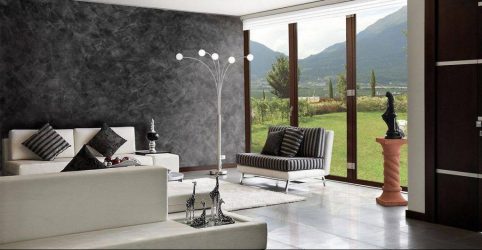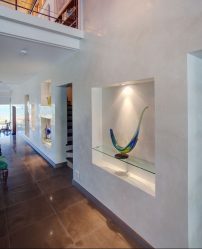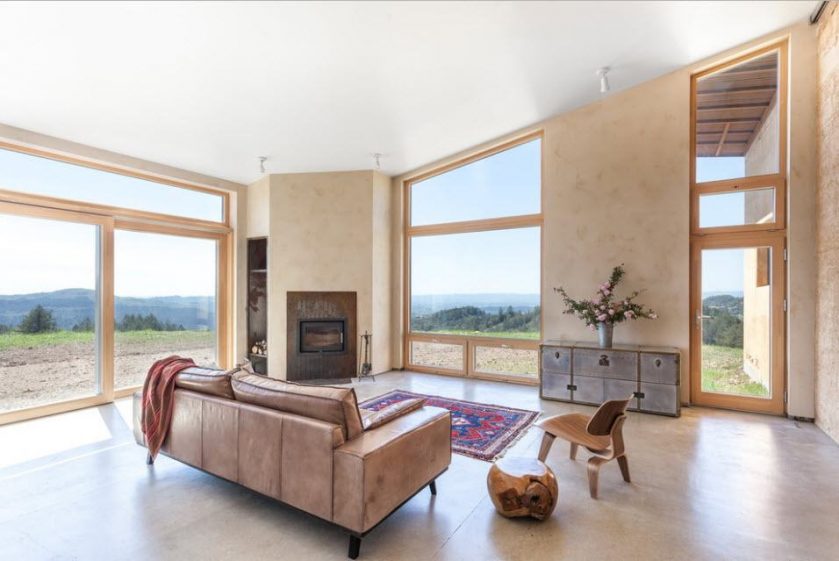
Venetian plaster in the interior will last a long century, over time it will become more beautiful and stronger. You will enjoy the variety of effects that she is capable of.
Content:
Venetian plaster (also known as “polished”) is a wall covering that mimics various noble surfaces — from polished marble to natural stone effects — for a luxurious decorative design. Its application was a laborious process, requiring patience and skill, so work was mainly limited to craftsmen.
Today, even a novice in the DIY industry can create impressive results. The coating imitates the appearance of plaster or polished marble, characteristic of European architecture of the old world. The modern version of Venetian plaster has a multidimensional appearance with a textured, slightly elevated surface, which is the result of two or more layers.
This interior decoration gained popularity in the 1550s in Venice, hence the name. It includes several layers of plaster applied with a spatula to create a three-dimensional effect. The final layer is trimmed to create a brilliant look.
Stucco Facts You Didn't Know
Polished plaster is a versatile, elegant decorative wall decoration used since the 1st century BC in traditional Italian architecture. Known for its durability and beautiful decoration, the method creates a stunning decorative effect that inspires, motivates, enhances the value of any building.
Venetian - is a special kind of polished plaster, mixed with marble dust, quartz or kaolin and applied with a spatula on the walls in a special way. It is painted to give the surface a wide range of colors. Depending on the method of application, distinguish methods called:
- marmorino (marmorino);
- scagliola;
- sgraffito (graffito).
It is applied in thin multilayer layers, which are then polished to create a smooth surface with the illusion of depth and texture. With proper use of Venetian plaster can be used to create a polished, stone, marble coating.It is especially useful on surfaces that are difficult to install marble panelsas well as on surfaces which imitated natural marble, for example:
- columns;
- ledges;
- curved walls.
Venetian plaster is one of the oldest building materials known to mankind.
The Romans learned to mix it with:
- marble dust;
- larger lime;
- sandy aggregate.
The same technique is used today by us.
Story
The Roman method became popular in Venice in the 15th century, where it was well adapted to classical architecture, which was valued among rich Venetians. In the local brick and tile industries there was a lot of terracotta waste, which was crushed to serve instead of sand, mixed with hydraulic lime.
Then they were applied to the walls to achieve a surface with a substantial “breathing” quality in the buildings. They were naturally exposed to moisture due to their location near the Venetian lagoon.
The stucco coatings were made from the excavation waste in the neighboring marble quarries, which were mixed with lime to get a style called Marmorino. It could be left whiteto imitate fashionable local stone or paint it to look like solid marble. Lighter plaster weight was a significant advantage for building on unstable ground in Venice.
Fashion has changed, and the use of Venetian plaster has declined markedly, until architect Carlo Scarpa revived it in the 1950s. Some of the more simple modern plaster made of synthetic acrylic resin - this option only mimics the famous recipe.
Varieties of plaster
Polished plaster can have many images, including marble, slate or stone, include stencils, logos and even have glitter in it. Applied in any color, with almost any effect.
It is applied directly to the walls, ceilings, windows - it is really universal, suitable for private houses or commercial buildings. It can be used in any room, even child's, as it does not contain toxic compounds.
return to menu ↑Marbled
The famous marbled plaster is called “Marmorino”. Literally means “small marble” in Italian: tiny marble particles are mixed with lime to create smooth, polished plaster.
Its surface is smooth, shiny, has a gradual movement between light and shade due to the skill of manufacturing, which gives a sense of depth and reflects light well. To the touch such a wall will be smooth, cold.
Marmorino can be applied to internal, external surfaces, it is suitable for finishing both modern and historical interiors. It has mold-resistant properties, excellent waterproofing, anti-bacterial properties, which makes it very desirable for luxury bathrooms rooms, other wet rooms. With age, the finish becomes stronger.
It is the most versatile of Italian plasters and can be used to make many textures, from polished marble to rustic, untreated, natural stones such as Travertine. It can be brought to the appearance with even gloss or marbled. It may have a variable degree of gloss depending on how long it has been polished. Finishing can be improved with color pigments.
Marmorino is available in different grades of grain, which gives many shades and decorative effects:
- thin marmorino;
- classic marmorino;
- matt marmorino.
Thin marmorino is suitable for achieving a smooth polished surface with a glossy effect and a noticeable play of light and shade.
Classic marmorino with a larger marble grain demonstrates thoughtful craftsmanship with a glossy shine. Matt marmorino is similar to modern tadelakt, where the surface is smooth, polished to satin finish with a flat decorative effect.
Marmorino for floor
Seamless smooth matte finish is suitable for use in areas where simple lines are needed. It is ideal for a minimalist environment due to its smooth uninterrupted integrity.
Suitable for modern and traditional interiors, recommended for use in low traffic areas such as bathrooms, kitchens, stairs, corridors or bedroomsand they should be treated with the same care as wood or wood. the floors from a soft stone.
The final effect also depends on the protective treatment. Flaxseed oil gives it the most natural look and is common in the role of final processing. Polyurethane varnish gives the surface a stronger finish that is harder to scratch and which has a more satin, closer to gloss finish. This, of course, non-slip surface, but sometimes apply special anti-slip procedures. Cleaning is very simple.
return to menu ↑Brilliant
This is a polished plaster with a true “WOW” factor. Made from very fine marble dust, it is applied with thin layers, and the last layer is polished to create a stunning high gloss and reflection with great depth.
With glitter, like a flawless mirror, this plaster is cool and sensual to the touch.. Unlike paint, this product has a high reflectivity from the corner and almost does not reflect the front.
This is a wall and ceiling decoration, suitable for almost any internal space, suitable for both modern and classic rooms, as well as residential and commercial.
return to menu ↑Textured
It is a plaster that is very similar to Marmorino, but has more sand and coarse aggregate, which makes it evenly coarse with slight variations in color. It is an ideal plaster to achieve the effect of natural stone and is available in fine and coarse textures. Durable, grainy appearance combined with a less polished surface to create the look and feel of refined or slightly polished limestone.
This finish is suitable for different interiors and is of high quality.Although it is visually inexpressive on large areas, it can be used as a rich background for combined walls and is often used in the design of walls with horizontal stripes to achieve variations in textures, as well as for working with emblems.
It is also used for external facade, as it has durability and functionality. The breathing properties of sand allow it to dry quickly and have a high pH, so it is also resistant to mold and bacteria. Being a natural lime based plaster, it has strong adhesion and is suitable for use on non-uniform surfaces such as brick, stone and concrete. It is resistant to cracking and self-healing, which means it will serve well under adverse conditions..
Pearl
Pearlescent sand obtained from shells was one of the elements used in antique Venetian plaster, since small pieces of shells were naturally present in the sand that was used to make plaster.
Metallic
In modern design, natural mother-of-pearl, which in antiquity was mined using the rubbing of shells, is used less and less. The most appropriate was the use of metal to get a similar effect.
This finish has a special brilliance and an attractive chromatic effect, suitable for prestigious interior decoration.oh The metallic effect is obtained by adding a large amount of fine multi-colored metal powder instead of the usual marble powder. It is available in silver, gold, bronze color.
This polished plaster has a sleek appearance, a thin velvety finish, which varies depending on the refraction of light from the surface and the point of view.
Venetian metal plaster personalizes any modern room, especially looks organically in high-tech design high tech. She also looks great in the dining room, office, restaurant, lounge or bathroom the room. On the other hand, you can apply it on the walls in living room, including in combination with the old furnishedto create amazing contrast.
return to menu ↑Travertine
Such a finish mimics the famous travertine stone - a particular form of light-colored limestone - and can be found in white, brown, cream, even rusty colors, has a fibrous or concentric appearance.
Plaster with the effect of travertine has a thin stone-like effect with a soft texture of varying degrees, depending on the grain size and method of application.
The surface has a slight shine, and although it is applied only in one shade, it has two or three distinct tones going across the surface.
Relief
This is a fibrous gypsum used to create dense, textured surfaces or uneven textured soil, due to the inclusion of a special ingredient - horsehair.
It is suitable for an antique effect, for decorating and dyeing decorative items, such as pearl or metallic wax.
return to menu ↑Designer plaster in the interior
Venetian polished plaster can certainly create the right factor that you are looking for. Be it a compact bathroom, a huge open layout, or on the external wall of a high profile, its color, texture, craftsmanship guarantee the right impression.
Smooth or textured, with wide or miniature strokes, modern or traditional - Venetian polished plaster will give your walls a style, sophistication, creating the background that you always wanted for your home.
Venetian plaster recalls the atmosphere of the old world, suitable for a romantic bedrooms or a unique dining room. It requires more work than traditional paint, therefore, the cost of it is more, so most homeowners use it selectively, and not in the whole house.
It imitates the classic architectural style of the Renaissance, when this decoration became so popular. Suitable for a high-end library or an accent wall in a gourmet kitchen.
Acrylic glaze reproduces such effects as:
- artificial antiquity;
- weathered walls.
There is only one drawback to these walls - it is difficult for a non-professional to achieve the effects that this technology is capable of. Of course, these projects have artistic skill, require an experienced hand of a master or a professional artist. Such advanced methods really need an expert touch to achieve good results. They may look just because of the uneven application, but the achievement of this look requires knowledge, skills, specific experience.
The coating also has waterproofing, anti-bacterial qualities, and, coupled with visual effects, it has become desirable for bathrooms and other wet rooms. It is an ideal alternative to floor, wall tiles. The plaster is not only resistant to water, but has fire resistance A1, therefore it is suitable for the kitchen, as well as other rooms with an open source of fire.
Venetian plaster is easy to clean, withstands steam, mold, fungus, serves as an alternative to tile.
return to menu ↑Venetian wall decoration in the kitchen
Venetian plaster adds texture, variety to the walls kitchens with its warm, earthly appeal. Since it resembles the characteristics found in stone, marble, it works well in kitchens that have rustic, Mediterranean or modern motifs. Because of the neutral tones for most Venetian plaster walls, you have many color options for the kitchen, but you need to make sure that your walls are combined, coordinated with your accessories, devices, accent colors.
return to menu ↑Elegant Earth Tones
Despite the fact that you can paint or apply Venetian plaster of almost any color, it seems most authentic when it contains soft earth tones, such as brown, bronze, beige, golden, taupe or darkgreen. These colors are very similar to the shades found in natural stone.
Choose a gray-brown or beige accent color if your plaster looks like a brown stone. Earth tones in Venetian plaster also look attractive when they are combined with stainless steel appliances, natural wood.
Inspired by the jewels
Venetian decoration is often used to decorate motifs that have a Mediterranean, Moroccan, Spanish style or European style of the old world. As a result, you can choose accent colors that reproduce the hues of the gems used decoratively in these regions. Venetian plaster goes well with colors such as:
- amber;
- sapphire blue;
- amethyst;
- ruby red;
- emerald green;
- Garnet;
- nephritis;
- golden topaz.
So that your kitchen does not seem too dark or dull, choose the muted shades of these precious tones. For example, you can choose a shade from the palette that is closer to the brighter end of the scheme than to the darker one.
return to menu ↑White, cream, ivory
Venetian finish is attractive when combined with shades of white or beige. Choose granite countertops in shades of cream or ivory to decorate your kitchen, pay attention to your Venetian walls. Such decor as:
- snow white cabinets;
- white tile;
- matt white light fixtures;
- white or cream decorative accessories.
Provide a bright contrast with the darker walls of Venetian finish. Stainless steel appliances, matte nickel hardware, rustic metal picture frames and pewter desk accessories are in good agreement with the overall design.
return to menu ↑20 shades of gray
You can consider gray as suitable for office, but it can be a good addition to the kitchen with plaster walls of Venetians. Dark shades of gray should be used sparingly so that the kitchen space that seems dark or disturbing does not work. You can choose charcoal granite countertops or charcoal gray. bar counters.
Living room
What could be more expressive for a living room than a stone wall? It is amazing how such a cold and heavy material can turn into a warm and attractive feature indoors. No matter what texture and colors you choose, you can combine it with many design styles. This finish adds a solid, durable appearance to an elegant, modern living room. It is also the perfect combination for a spacious space with a dining area. Accent Venetian stone wall adds dynamics to the room, as well as a brilliant way to hide damaged plasterboard or plaster surfaces.
return to menu ↑The combination of plaster and brick
Try to combine the plaster with different surfaces, for example, with brickwork, to get the Loft style in your living room.You can also choose a different architectural stone for interior decoration, which comes in a wide variety of organic shapes, surfaces and shades that will work with almost any interior color palette. Or maybe you will discover the possibilities of your living room to reproduce historical design using this combination - for example, Art Deco.
Bedroom
Venetian plaster, of course, will be relevant in any era, because it is a natural material, in which there is a depth and heat that nourish the soul.
The type of texture you select will have a decisive effect on the wall finish. Sandy textures can be used to imitate the appearance of granite or natural stone, and more subtle textures will give you the look of old plaster, marble or even suede. The method used to apply textured paint also affects the appearance of the finish. The use of color and how it is applied to the wall will be the final stage in creating the illusion of antique or artificially aged plaster.
Create in your the bedroom A special wall is a simple but very effective way to transform a room. if you have fireplace, beat it with plaster, with which it will always look advantageous, as in itself is the central focus in the room, most often.
Entrance hall
Venetian decoration can be a way to hide the flaws or unwanted textures on the walls. Although plaster is more expensive, it is much more versatile in terms of design, and also much more durable than other types of coating - for example, than drywall. It is easier to apply than some types. wallpaper, linen texture, which must first be plastered if the surface of the walls is uneven.
Ideas for the hallway:
- Apply a shimmering top metal finish under gold or mother of pearl, or what about oxidized metal or rust for urban grunge?
- Immortal marble in the corridor also looks appropriate and is suitable not only for the Tuscan or English style, but also for any modern. Such a decor does not make even a small and narrow room heavy;
- show with it rich textures of lace, flax and suede.
Add parquet flooring and local lighting to make your entryway enchant everyone.
return to menu ↑Bathroom
The material allows you to create seamless cover without any solution. It is also incredibly versatile, available in any color and, depending on the final species you want to achieve, it can be applied using a variety of methods. Whether it is smooth or textured, with a matte finish or polished to a high gloss, the final product can be adapted to create a beautiful finish.
By applying special waxes that protect your walls, polished plaster allows you to create a unique look in the bathroom that will stand the test of time.
return to menu ↑Decorative plaster
In addition to using this technology, a lot of new approaches are used to imitate the famous finish with cheap materials, but without loss in quality and functions. Thus, decorative plaster was born - a cheaper gypsum analogue of the Venetian, which, however, retained its basic properties in terms of functionality and aesthetic appearance.
Like Venetian, it is applied manually and dries into a very strong surface, which can last for quite a long time - until it is damaged by water, cracks or flakes.
It is quite flexible material and is suitable for application to a brick, stone, semi-circular or frame construction. Provides a durable surface that is easy to clean and that can be applied to flat or curved walls and ceilings.
You can also apply some effects to it:
- you can get a stencil;
- decorative painting;
- wallpaper;
- or white.
This type and adaptability of the material to almost any size, shape or configuration of the building determined that gypsum plaster was chosen for almost all buildings up to the 1930s and 40s in Europe.
return to menu ↑Polished Gypsum Stone
It is very similar to marmorino and is obtained by adding light and dark marble grains, creating stains inside the plaster, which distinguish this finish from others.
Do-it-yourself Mediterranean-style wall designs
One of the fashion trends in decorating the house is to bring the details of the Mediterranean style to the interior. You can bring some of the wealth and warmth of Italian villas to your home using a few simple and creative ideas and give your walls a unique and stylish look.
When choosing a Mediterranean-style pigment, choose heavenly colors and warm hues in any range from warm white to golden brown or cool light blue, pastel and turquoise blue. The more intense the color, the richer and darker the finished effect will look.
Plaster work can be made of any color, but when using multiple colors, depth and expressiveness are added. The surface, when the work is finished, looks smooth and very decorative.
Venetian plaster
Master Class
